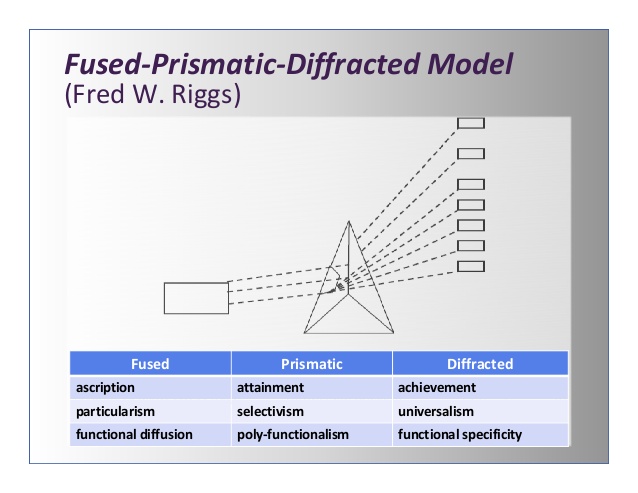-
Chapter 5: RIGGS COMPARATIVE MODEL
Introduction to Riggsian theory
Every culture offers support and obstacles to change and development. Riggs wanted to demonstrate how external conditions influence administrative systems.
Three Tools:
- Ecological approach
- Structural - Functional
- Ideal models.
Ecological Approach: Administration is one subsystem of a society and so is influenced by other subsystems viz. political, social, cultural and economic dimensions.
Structural Functional Approach: Society has many structures that perform various functions viz. political, economic, social, symbolic, communicational. The same set of functional requisites apply to a administrative subsystem.
Ideal Models: Based on structural functional models. There are two models:
- Agraria - Industria
- Fused - Prismatic - Diffracted.
Agraria - Industria Model
All societies are either agro dominant or industrial. The shift from agro to industrial is compulsory and unidirectional.
| Agriculture dominant | Industrial dominant |
| Ascriptive values i.e. people are placed in social classes based on birth or other factors. | achievement oriented classification |
| particularistic norms | universalistic norms |
| diffuse patterns | specific patterns |
| stable local groups and low spatial mobility | high mobility |
| simple occupational differentiation | egalitarian class system |
| Few administration structures. Function not specified. Primordial preferences given priority like caste |
Drawbacks:
- Transitia society less developed. Doesnt help in examining it.
- No mechanism to study mixed society
- Even industrial society have agriculture
- Assumes unidirectional movement
- Stresses on environment of administration system not administration systems.
- Too general and abstract.
Fused Prismatic Diffracted Model
Represents underdeveloped, developed and developing societies. Traditionally agriculture, folk, societies are fused, industrial societies are diffracted and intermediate ones are fused. Thus fused society is where a single structure performs many functions and diffracted one is where a single structure performs limited functions.
Prismatic model of developing countries:
- Heterogeneity: It means a society is divided into haves and have nots. the bureaucracy would protect interest of haves and ignore havenots leading to a revolution.
- Formalism: The difference between stated and practised is high. thus bureaucracy plays dominant role in policy making as executive is busy in power politics.
- Overlapping:New structures are still dominated by old systems. thus parliament, markets are present but still dominated by family, caste, traditions etc.

Prismatic Sala model
Riggs analyzed interaction between the administration system and its environment in prismatic societies. His Prismatic Sala model represents a traditional or developing society and 'Sala' is the administrative sub-system of it.
Features of Prismatic Sala model:
- Heterogeneity: High degree of heterogeneity in a prismatic society due to simultaneous presence of different kinds of systems, practices and viewpoints.
- Formalism: High degree; due to discrepancy between formally prescribed and effectively practices i.e. between norms and reality.
- Overlapping: High degree; due to formally differentiated structures of a diffracted society co-exist with a undifferentiated structures of a fused society.
- Nepotism: 'Sala' has nepotism in recruitment.
- Poly-normative: Co-existence of modern, traditional norms leading to lack of consensus on norms of behavior.
- Poly-communal: Hostile co-existence of communities.
- Bazaar canteen system: The economic subsystem which combines both market economy and traditional economy. Hence prices of goods keep fluctuating. A small section exploits a large number and controls economic institutions. Prices of goods is determined by relationship between people and officials so it varies largely. In this model, market factors are developed without increase in capital so businessmen try to increase their influence on politics and administration for personal ends. Black market, adulteration, hoarding, inflation is seen. Exploitation, poverty, social injustice are main features.
- Authority and Control:Authority is centralized but control is localized so dominance of administrators is seen.
Change in a prismatic society:
- Pace of development is related to sources of change. Western societies change their effective behavior to evolving behavior as they have longer timespan for development. Hence they experience low heterogeneity, formalism and overlapping.
- Change can be exogenous, endogenous or equigenous. An exogenous society faces more heterogeneity, formalism and overlapping than endogenous as the effective behavior precedes establishment of new formal institutions in endogenous.
- Prismatic societies face problems of greater heterogeneity, formalism and overlapping in their bid to absorb exogenous change in shortest time.
Critics:
- Difficulty in language and terms borrowed from sciences.
- Lack of change orientation i.e. equilibrium models and so not helpful in introducing social change in system.
- No quantitative levels to measure levels of prismatic and diffraction.
- Focus on negative character of prismatic society.
- Societies are characterized into fused, prismatic, diffracted on basis of capitalist values and so no ethnocentric.